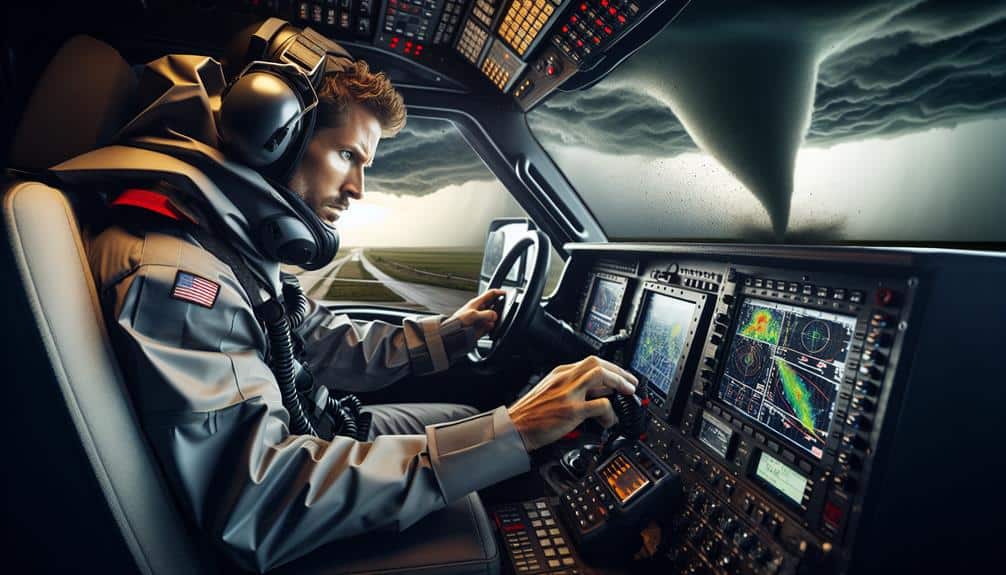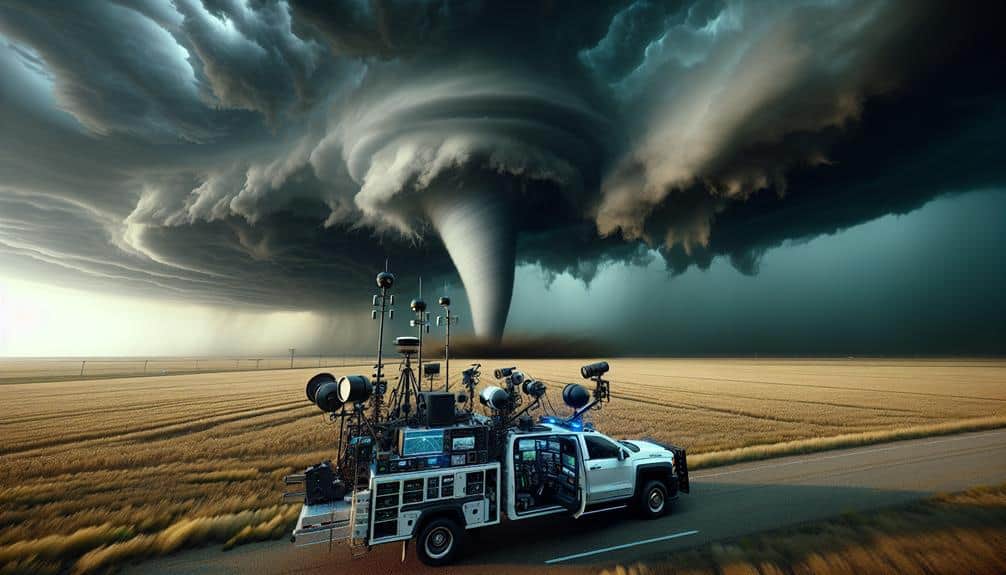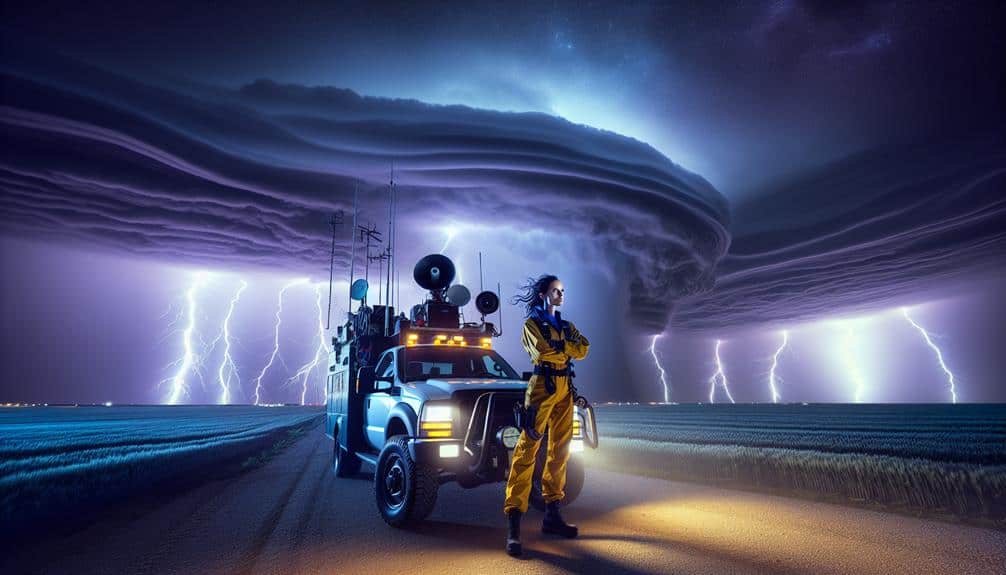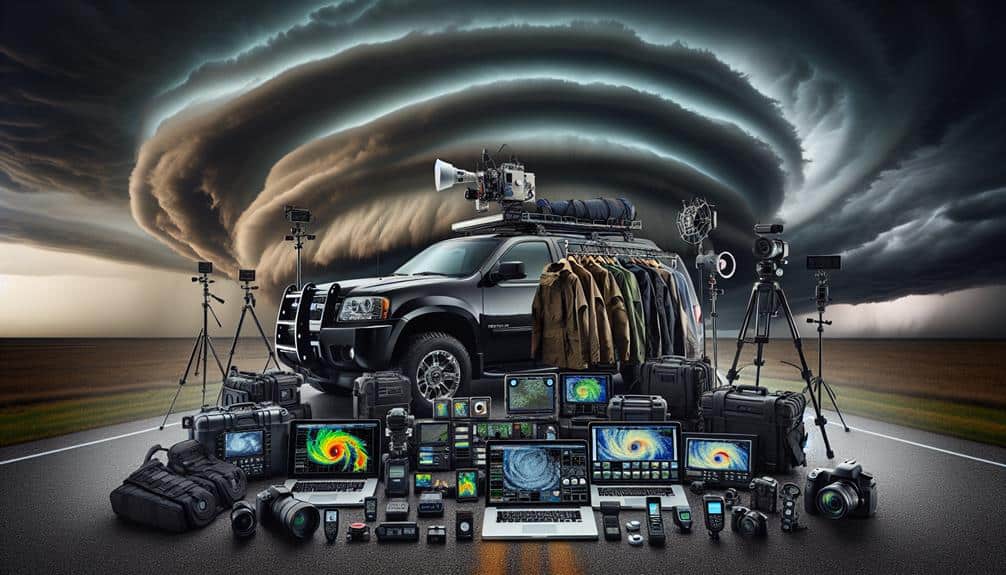Capturing incredible storm chasing photos requires meticulous preparation and awareness of weather conditions. We'll prioritize durable, weatherproof gear, including versatile lenses and carbon fiber tripods. Understanding weather patterns is vital; we study radar images and use reliable sources like the National Weather Service. Location selection is key—opt for open areas ahead of the storm's path, ensuring multiple escape routes. Mastering manual camera settings such as exposure, shutter speed, and aperture is essential for dramatic shots. Safety is paramount: follow strict protocols, use protective gear, and travel in teams. For an in-depth guide, we've got more expertise to share.
Key Points
- Use weatherproof cameras and carbon fiber tripods for durability and stability in harsh conditions.
- Master manual camera settings to control exposure, shutter speed, and aperture for dramatic storm photos.
- Choose versatile lenses to capture both wide landscapes and detailed close-ups effectively.
- Monitor real-time weather updates and analyze radar data for accurate storm tracking and positioning.
Selecting the Right Gear
When selecting the right gear for storm chasing photography, we must prioritize durability, weather resistance, and high-speed performance.
First and foremost, weatherproof cameras are non-negotiable. Our equipment will face harsh conditions, so investing in gear built to withstand the elements is essential. Gear maintenance is also essential; regular checks and cleaning will ensure our cameras perform at their best, even in adverse weather.
Next, let's talk about lens selection. We need a versatile lens that can handle wide shots of storm landscapes and zoom in for detailed close-ups. A 24-70mm lens is a solid all-around choice, balancing wide-angle and telephoto capabilities. For those dramatic thunderstorm shots, a wide-angle lens like 16-35mm can capture the vastness of the sky.
Tripod stability is another vital element. Our tripods must be robust enough to withstand strong winds and uneven terrain. Carbon fiber tripods offer a good mix of stability and portability, ensuring our shots remain steady even in the most turbulent conditions. Always use a tripod with a hook for additional weight, providing extra stability when the wind picks up.
Understanding Weather Patterns
Understanding the complexities of weather patterns is vital for predicting storm movements and positioning ourselves for the best photographic opportunities. We must explore weather forecasting and storm tracking techniques to stay ahead of the game.
Reliable sources like the National Weather Service or specialized storm tracking apps provide the data we need. By analyzing radar images and satellite data, we can identify potential storm formations and their trajectories.
With climate change contributing to more frequent and intense extreme weather, our approach must be both adaptive and cautious. Recognizing the signs of developing supercells, squall lines, and other severe weather phenomena allows us to make informed decisions about when and where to set up for a shot. It's essential to understand weather models and interpret atmospheric conditions like wind shear, humidity levels, and temperature gradients.
Safety remains paramount. The thrill of capturing that perfect storm photo should never override our need to avoid hazardous situations. We need to continuously update our knowledge and skills in weather forecasting and storm tracking, ensuring we're not just chasing storms but also outmaneuvering them.
This expertise empowers us to seize the stunning, raw beauty of extreme weather while preserving our well-being.
Finding the Perfect Location
Choosing the best vantage point involves evaluating terrain features, accessibility, and potential safety hazards to guarantee both captivating visuals and personal safety. When scouting spots, we should prioritize open areas with minimal obstructions, such as plains or elevated terrains. These locations provide an unobstructed view of the horizon, essential for capturing expansive storm structures.
Strategic positioning is key. We need to place ourselves ahead of the storm's path, ideally on its southeast side to capitalize on optimal lighting and avoid the core's most dangerous elements. Access to multiple escape routes is vital for safety, so we should familiarize ourselves with local roads and make sure our vehicle is reliable and fully fueled.
Monitoring the storm's progression in real-time allows for dynamic repositioning, giving us the freedom to adjust our location as needed. Knowing the terrain's layout helps us avoid potential hazards like flooding, downed power lines, or debris.
Lastly, using topographic maps and GPS devices enhances our ability to find and reach the perfect spot. Staying aware of weather updates and having a solid communication plan ensures we can enjoy the thrill of storm chasing while maintaining our safety.
Mastering Camera Settings
To capture the raw power and beauty of storms, we must fine-tune our camera settings to adapt to the challenging and rapidly changing conditions. Start by mastering exposure control.
We should use manual mode to have full authority over shutter speed, aperture, and ISO. For dramatic lightning shots, a longer shutter speed (around 10-30 seconds) can be vital. Adjusting the aperture to f/8 or f/11 will help maintain depth of field and sharpness.
In low-light conditions, a higher ISO might be tempting, but we should be cautious to avoid noise. Instead, a sturdy tripod and remote shutter release can keep our shots crisp without bumping up ISO unnecessarily.
Mastering lighting techniques is essential; using a graduated neutral density filter can balance the exposure between the stormy sky and the darker landscape below.
Composition skills are paramount—placing the storm strategically within the frame can convey its magnitude and drama.
After capturing our shots, we can refine them using editing software like Adobe Lightroom. Here, we can fine-tune exposure, contrast, and clarity, ensuring our photos truly reflect the storm's intensity.
Ensuring Safety Precautions

Prioritizing our safety is vital when chasing storms, as the raw power we're excited to photograph can also pose significant risks. To capture breathtaking images without compromising our well-being, we must adhere to strict safety protocols. Having a well-structured emergency plan and the right protective gear is non-negotiable.
First, let's outline our key safety measures:
- Develop an Emergency Plan: Before heading out, we must map out escape routes, identify safe shelters, and establish communication protocols. Knowing exit strategies can make the difference between a thrilling adventure and a risky situation.
- Equip Protective Gear: Proper attire like sturdy, waterproof boots, high-visibility jackets, and helmets are essential. Additionally, having first aid kits, fire extinguishers, and weather radios on hand ensures we're prepared for unexpected events.
- Monitor Weather Updates: Real-time weather data from trusted sources is invaluable. Apps and satellite systems can provide timely alerts, enabling us to adjust our positioning and avoid dangerous zones.
- Travel in Teams: Never chase storms solo. Partnering with experienced storm chasers enhances situational awareness and provides mutual assistance during emergencies.
Frequently Asked Questions
How Do You Edit Storm Photos to Enhance Their Dramatic Effect?
To enhance the dramatic effect, we start with editing techniques like creative filters and precise color adjustments. By adjusting contrast and saturation, we make storm photos more striking, ensuring every bolt and cloud looks intensely vivid.
What Are the Best Times of Day for Storm Photography?
For capturing dramatic storm photos, we should target the golden hour for evening storms and sunrise for morning thunderstorms. These times offer ideal lighting and striking contrasts, though we must always prioritize safety when chasing storms.
How Can I Protect My Camera Equipment During a Storm?
When the storm rages, we can't risk our gear. We use waterproof gear and protective cases. Ensuring everything's sealed tight, we protect our investment while capturing nature's fury, balancing safety with the thrill of the chase.
What Post-Processing Software Is Recommended for Storm Photos?
For post-processing storm photos, we recommend Lightroom vs Photoshop. Lightroom presets offer quick, high-quality adjustments, while Photoshop provides detailed edits. Use both for ultimate control and creativity, ensuring your storm images captivate and inspire.
How Can I Capture Lightning in My Storm Photos?
Did you know that 100 million volts can be in a single lightning bolt? For better lightning composition, use a tripod and long exposure. Mastering storm photography techniques requires patience and awareness of weather risks.


